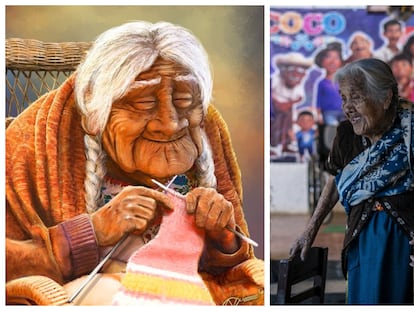Ten horror and fantasy film heroines who triumphed amid violence and gore
The premieres of ‘Halloween Ends’ and ‘Piggy’ bring back female fighters who defeat ruthless killers in worlds brimming with evil


The recent premieres of Halloween Ends, the last movie in John Carpenter’s franchise, and Piggy, a film that has revolutionized Spanish horror films with an exceptional leading actress and the talent of its director, Carlota Pereda, are prompting a review of the heroines of the horror genre. These are women who manage to overcome all kinds of violence to thwart the killers who hunt them, usually by employing even more violence than their assailants and, naturally, by outsmarting them. We have compiled a list the 10 most outstanding female main characters.
Laurie Strode, in the Halloween films (1978-2022). Strode is the archetype that gave rise to two trends that have characterized horror movies: scream queens and final girls. Scream queens were born in the 1970s, and as Laurie Strode in Halloween (1978), Jamie Lee Curtis defined the character for the generations that followed; the main characters in The Last House on the Left (1972), Texas Chainsaw Massacre (1974) and, later, Friday the 13th (1980) and Nightmare on Elm Street (1984) also belong to the same category. Scream queens are not just attractive and frightened, but also intelligent and romantic women: Ann Darrow, the character Fay Wray brought to life in King Kong (1933), was one of their predecessors. Many, but not all, scream queens are also “final girls,” the ones who confront the serial killer in the final battle (especially in the slasher subgenre, which features blood, guts, psycho killers and stabbings). Curtis, as Laurie Strode, has been fighting Michael Myers for 44 years; now, as the title Halloween Ends indicates, she finally concludes her battle.
Lieutenant Ripley, in the Alien saga (1979-1997). She is a fundamental figure in the universe of empowered women, especially in the world of science fiction, which had previously lacked them. Moreover, Sigourney Weaver was nominated for an Oscar for her performance as Ellen Ripley in the second installment of the film franchise, Aliens (1986), an unprecedented feat for a role in this genre. Weaver is Ripley, and Ripley is Weaver; one cannot be understood without the other, and both became film icons. The lieutenant is a warrant officer on the Nostromo spaceship, but her strength and courage make her the crew’s only survivor of the xenomorph, or alien’s, attacks. The sequels made it clear that without Ripley, Alien is an inert film franchise; that’s why the character was cloned and resurrected, 200 years after her death, in Alien: Resurrection (1997).
Sarah Connor, in the Terminator movies (1984-2019). Ripley’s closest heir is Sarah Connor, the mother of resistance leader John Connor in the Terminator saga. In film and on television, three actresses have portrayed Sarah Connor, who goes from waitress to furious warrior after different Terminators cross her path. Linda Hamilton’s charisma in her portrayal of Sarah Connor was central to the character’s magnetism. That’s why the actress’s return to the screen in Terminator: Dark Fate (2019) was a precious cinematic act of poetic justice.
Sidney Prescott, in Scream (1996-2022). Kevin Williamson wrote a very clever script. It takes the obsessions of teenage horror films and turns them around to have the audience laugh at them in a film directed by Wes Craven. He begins with the concept of a lonely girl who is stalked by an intruder wearing a mask that covers his face, but here the stalking is done by phone, and horror movies are a part of the game. It’s good meta-cinema. Neve Campbell played Sidney in five films, the last of which was released a few months ago; the actress clearly understands how to portray a character who symbolizes strength and, as a woman, refuses to be a victim.
Julie James, in I Know What You Did Last Summer (1997). Four friends accidentally kill a man and vow that no one will ever find out what happened. A year later, one of them, Julie, receives a note that reads: I know what you did last summer. From that moment on, something happens to each of them. Only Julie (Jennifer Love Hewitt) will be able to face him... and defeat him. And then defeat him again (there was a sequel). Kevin Williamson’s script was written before Scream, but studios didn’t want to finance the movie until after Scream’s blockbuster success. As with many of these characters, Love Hewitt elevates her character above some of the script’s weaknesses; that’s why she returned to star in I Still Know What You Did Last Summer (1998). However, the actress does not like slasher films and has not acted in that genre since, though she did film a series, Ghost Whisperer, which features supernatural characters.
Alice, in the Resident Evil saga (2002-2016). Alice didn’t exist in the video game on which the Resident Evil film series is based, although there were other powerful female characters. In the film, Dr. Alexander Isaacs creates a clone of Alice Markus to unleash an apocalypse on Earth from which a new world will be born. But Alice rebels against her preordained fate. Milla Jovovich has played her in all six films, and she gave the Resident Evil franchise its magic. An heir to Ripley and Connor, Alice’s birth as a clone and her genetic improvements over time have made her almost indestructible. The final installment, Resident Evil: The Final Chapter (2016), ends with the enigmatic declaration that “the fight is not over.”
Beatrix Kiddo, in Kill Bill (2003-2004). Beatrix Kiddo (the black mamba, or the Bride) is another legendary character born of Quentin Tarantino’s imagination, who obviously benefits from Uma Thurman’s performance; she brings Beatrix to life in a state of grace. Tarantino and Thurman co-created the Bride character when they were filming Pulp Fiction. With her yellow tracksuit and sword, Kiddo is the avenger par excellence. After leaving the Deadly Viper assassin group, she finds out that she is pregnant and wants to build a better life for her baby. Out of jealousy, Bill, the group’s leader, orders her assassination, but the murder fails. When Kiddo wakes up from the coma caused by the attempt on her life, nothing and no one can stop her.
Clara, in [REC]3: Genesis (2012). Spanish director Paco Plaza brought this franchise to its long-awaited climax, which gave us the iconic image of Clara, the main character, mowing down infected people with a chainsaw as blood splatters on her wedding dress. They blew up her wedding, so she will eliminate as many of them as she can. While the main character of the first two [REC] films, anchorwoman Ángela Vidal (Manuela Velasco), was a character who served to guide viewers, Clara (Leticia Dolera) plays a much more active role.
Imperator Furiosa, in Mad Max: Fury Road (2015). Cinema owed Charlize Theron a character like Imperator Furiosa, a fighter impervious to discouragement. She is the captain of Immortan Joe’s army, until she rebels and decides to free the dictator’s concubines (the so-called brides), which displeases Joe. Yes, Mad Max also appears in George Miller’s film, but he is just a secondary character who is subject to Furiosa’s whims. The fascination with Imperator Furiosa has prompted Miller to shoot a prequel, now in production, titled, simply, Furiosa, which stars Anya Taylor-Joy.
Sara, in Piggy (2022). This recently premiered horror movie is a slasher film that incorporates spectacular additional elements. Set in a village in Extremadura, Spain, the movie plays on Spanish clichés, one of which is eating lots of pork, and delves into today’s fatphobia. The film’s director and screenwriter, Carlota Pereda, uses the movie to reflect on the harassment of obese teenagers, evil’s eternal attraction, and the human need to feel heard. As Pereda says, “Piggy is an ode to those who are different; the main character is neither thin nor an especially good person. Sara is simply human.” The film is a gamechanger in the Spanish horror genre for a variety of reasons, especially its exceptional star, Laura Galán, the actress who plays Sara.
Tu suscripción se está usando en otro dispositivo
¿Quieres añadir otro usuario a tu suscripción?
Si continúas leyendo en este dispositivo, no se podrá leer en el otro.
FlechaTu suscripción se está usando en otro dispositivo y solo puedes acceder a EL PAÍS desde un dispositivo a la vez.
Si quieres compartir tu cuenta, cambia tu suscripción a la modalidad Premium, así podrás añadir otro usuario. Cada uno accederá con su propia cuenta de email, lo que os permitirá personalizar vuestra experiencia en EL PAÍS.
¿Tienes una suscripción de empresa? Accede aquí para contratar más cuentas.
En el caso de no saber quién está usando tu cuenta, te recomendamos cambiar tu contraseña aquí.
Si decides continuar compartiendo tu cuenta, este mensaje se mostrará en tu dispositivo y en el de la otra persona que está usando tu cuenta de forma indefinida, afectando a tu experiencia de lectura. Puedes consultar aquí los términos y condiciones de la suscripción digital.
More information
Archived In
Últimas noticias
Most viewed
- Sinaloa Cartel war is taking its toll on Los Chapitos
- Oona Chaplin: ‘I told James Cameron that I was living in a treehouse and starting a permaculture project with a friend’
- Reinhard Genzel, Nobel laureate in physics: ‘One-minute videos will never give you the truth’
- Why the price of coffee has skyrocketed: from Brazilian plantations to specialty coffee houses
- Silver prices are going crazy: This is what’s fueling the rally











































